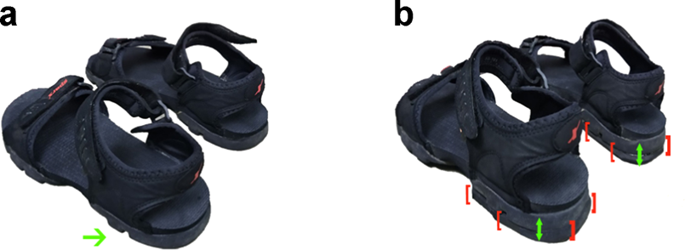Spinal Cord Series and Cases ( IF 0.7 ) Pub Date : 2020-03-17 , DOI: 10.1038/s41394-020-0266-9 Akhil John Kurien 1 , Thangavelu Senthilvelkumar 1 , Jacob George 1 , Vanjeeth Kumar 1 , Grace Rebekah 2

|
Study design
Non-randomized within-subject experimental study.
Objective
To determine whether the addition of the 1 cm heel lift to the footwear improves the walking ability of the persons with Cauda Equina Syndrome (CES).
Setting
Department of Physical Medicine and Rehabilitation, Christian Medical College, India.
Methods
Fourteen people with bilateral plantar flexor weakness following traumatic CES (mean age 43.7 years) were recruited for the study. Their walking speed, stride length, cadence, and time taken to complete Timed Up and Go (TUG) were measured using footwear with back straps. Then, the 1 cm heel lift was attached to the sole of the footwear. After sufficient practice, all the parameters were reassessed to find out the effectiveness of the heel lift.
Results
With the 1 cm heel lift, the participants walked 0.13 m/s (95% CI, 0.08–0.17) faster than their regular footwear. They were able to complete the TUG test 2.6 s (95% CI, 1.4–3.7) earlier than before. There was an increase of 5.2 in. in stride length (95% CI, 2.9–9) and an eight steps increase in cadence (95% CI, 4.9–11.3) observed after the heel lift.
Conclusions
This pilot study has demonstrated that addition of 1 cm heel may be effective in improving the walking performance of persons with Cauda Equina Syndrome. Future studies should investigate the kinetic and kinematic changes of this modification using a randomized controlled trial study design.
中文翻译:

提踵提高外伤性马尾综合征患者的步行能力——一项试点实验研究
学习规划
非随机受试者内实验研究。
客观的
确定在鞋履上增加 1 厘米的鞋跟提升是否能提高马尾综合征 (CES) 患者的步行能力。
环境
印度基督教医学院物理医学与康复系。
方法
研究招募了 14 名在创伤性 CES 后双侧足底屈肌无力的人(平均年龄 43.7 岁)。他们的步行速度、步幅、步频和完成 Timed Up and Go (TUG) 所需的时间是使用带背带的鞋子测量的。然后,将 1 厘米的鞋跟提升装置连接到鞋底。经过充分的练习,重新评估所有参数以找出脚跟提升的有效性。
结果
脚跟抬高 1 cm 后,参与者的步行速度比普通鞋类快 0.13 m/s(95% CI,0.08-0.17)。他们能够比以前提前 2.6 秒(95% CI,1.4-3.7)完成 TUG 测试。脚后跟提升后,步幅增加了 5.2 英寸(95% CI,2.9-9),步频增加了 8 步(95% CI,4.9-11.3)。
结论
这项初步研究表明,增加 1 厘米的鞋跟可能有效改善马尾综合征患者的步行能力。未来的研究应该使用随机对照试验研究设计来调查这种修改的动力学和运动学变化。











































 京公网安备 11010802027423号
京公网安备 11010802027423号